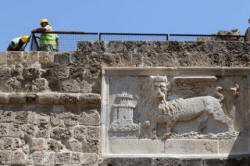|
 Shakespeare's
'Othello Tower,' victim of Cyprus's division, to reopen
after facelift Shakespeare's
'Othello Tower,' victim of Cyprus's division, to reopen
after facelift
 Send a link to a friend
Send a link to a friend
[June 18, 2015]
By Michele Kambas
FAMAGUSTA, Cyprus (Reuters)
- The 14th-century Cypriot tower that is the fictional
setting of Shakespeare's play "Othello" reopens next
month after undergoing renovation following decades of
decay on the internationally isolated Turkish side of
the ethnically divided island.
|
|
 The "Othello Tower" was long a tourist magnet. But after
Cyprus was partitioned by a 1974 Turkish invasion triggered by a
brief Greek-inspired coup, hundreds of the island's heritage
sites fell foul of what became a frozen conflict. The "Othello Tower" was long a tourist magnet. But after
Cyprus was partitioned by a 1974 Turkish invasion triggered by a
brief Greek-inspired coup, hundreds of the island's heritage
sites fell foul of what became a frozen conflict.
Part of a fortress in the medieval city of Famagusta just within
the Turkish side of Cyprus's "Green Line" on the eastern coast,
the tower has been undergoing emergency stabilization for the
past year to protect it from extensive water damage.
According to the Bard, it was in the tower that the dark-skinned
Moor Othello, egged on by his supposed trusty adviser Iago, goes
into a jealous rage over the alleged infidelity of his new bride
Desdemona and smothers her. In true Shakespearean fashion,
Othello takes his own life after realizing his mistake.
Barricaded to visitors for the past 11 months, the tower will
reopen in July -- fittingly with a performance of the
Shakespearean drama by young Turkish and Greek Cypriot actors.

"This is part of our common heritage," said Glafcos
Constantinides, a member of a joint team of Greek and Turkish
Cypriot cultural experts tasked with salvaging monuments on the
Mediterranean island, showing it off during a press preview.
"Our heritage comes from the past, but also what we expect to
build in the future."
The restoration project is one of several earmarked by a group
of Greek and Turkish Cypriots who, acting with the approval of
their respective political leaderships as inter-communal
tensions along the Green Line have eased in recent years, are
working to conserve Cyprus's cultural heritage.
[to top of second column] |

"Our biggest challenge was the rainwater. The complex absorbs it
like a sponge," said Fatma Terlik, contract manager for the project
carried out under the supervision of the United Nations Development
Programme with European Commission funds.
A drainage system was installed, together with work to restore some
of the walls of the building, she told Reuters.
Famagusta lies just within internationally unrecognized northern
Cyprus, a breakaway Turkish Cypriot state reliant on economic aid
from Ankara and an area traditionally shunned by international
conservation projects for political reasons.
The imposing fortress was built by Lusignan conquerors in the 14th
century. It was remodeled and expanded in the 15th century by the
Venetians, whose winged Lion of St. Mark emblem is still clearly
visible, carved over its portal.
(Editing by Mark Heinrich)
[© 2015 Thomson Reuters. All rights
reserved.] Copyright 2015 Reuters. All rights reserved. This material may not be published,
broadcast, rewritten or redistributed.
 |